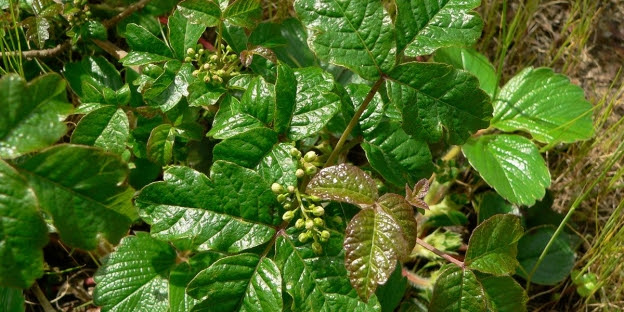 California Poison Control System (CPCS) warns California residents that the recent heavy rains resulted in a bumper crop of poison oak. It is a serious threat, especially to those who are allergic to the plant. Poison oak (Toxicodendron diversilobum) is found mainly in the western regions of the state growing from sea level to the mountains. Grassy hillsides, forests, recreation areas, and coastal locations are home to the plant.
California Poison Control System (CPCS) warns California residents that the recent heavy rains resulted in a bumper crop of poison oak. It is a serious threat, especially to those who are allergic to the plant. Poison oak (Toxicodendron diversilobum) is found mainly in the western regions of the state growing from sea level to the mountains. Grassy hillsides, forests, recreation areas, and coastal locations are home to the plant.
Identifiable by its climbing vine-like appearance, the University of California, Agriculture and Natural Resources describes poison oak as forming a dense, leafy shrub from one to six feet high. Leaves normally consist of three leaflets with the stalk of the central leaflet being longer than those of the other two and it has either glossy or dull leaves. (Photo by Eric Poelzl/Parks Conservancy)
“There’s a saying, ‘Leaves of three, let it be,’ among hikers. In addition to coming in contact with the plant itself, you can contract poison oak by touching clothing, shoes, gloves, pets, and tools. Even smoke from burning plants can cause irritation,” says Dr. Rais Vohra, Medical Director for the Fresno/Madera Division of CPCS. He added that exposure in allergic individuals can result in a rash about one to six days after exposure that itches and then forms water blisters. The fluid from these blisters does not transmit poison oak as many people think. Repeated exposure does, unfortunately, increase sensitivity. Poison oak tips include:
- Wear boots, gloves, and long pants when hiking.
- Stay on trails away from brushes where poison oak plants grow.
- If you are exposed to poison oak, wash the area thoroughly with lukewarm water and apply rubbing alcohol which may wash away the oil from the plant.
- Wash all clothing, tools, and pets that have been exposed to the plant.
- Calamine lotion or hydrocortisone cream can help stop the itching, as can antihistamines.
- Do not scratch the rash as that can cause infection.
- Get immediate medical attention if you have trouble breathing or swallowing; the rash covers much of your body; you have many blisters; or swelling occurs, especially of the eyelids, face, or genitals.
- Visit and share the CPCS website link at https://calpoison.org/about-
poison-oak
About CPCS
Call Poison Control at 1-800-222-1222 (the number is the same in all states)for questions about poison encounters. Trained pharmacists, nurses, and other providers are available to help 24 hours a day, seven days a week. The service is free, and confidential with interpreters are available. Get weekly tips about safety by texting TIPS to 20121 for English or texting PUNTOS to 20121 for Spanish. Follow CPCS on Facebook and on Twitter @poisoninfo. CPCS is part of the University of California San Francisco School of Pharmacy and is responsible to the California Emergency Medical Services Authority.




















